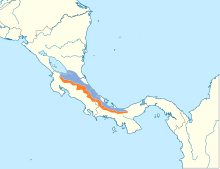Bare-necked umbrellabird
| Bare-necked umbrellabird | |
|---|---|

| |
| Male | |
| Scientific classification | |
| Domain: | Eukaryota |
| Kingdom: | Animalia |
| Phylum: | Chordata |
| Class: | Aves |
| Order: | Passeriformes |
| Family: | Cotingidae |
| Genus: | Cephalopterus |
| Species: | C. glabricollis
|
| Binomial name | |
| Cephalopterus glabricollis Gould, 1851
| |

| |
The bare-necked umbrellabird (Cephalopterus glabricollis) is a species of
. Bare-necked umbrellabirds live only in forests and their diet consists mainly of fruits.Its natural
Taxonomy and systematics
Description
The bare-necked umbrellabird is a large, bulky, and crow-like bird, being the largest passerine in its range. It is also among the largest of the cotingas, with only the Amazonian umbrellabird being larger. The males are larger than the females, being 41 cm (16 in) in length and weighing 450 g (16 oz), compared to the females' 36 cm (14 in) and 320 g (11 oz).[5]
Distribution and habitat
The bare-necked umbrellabird is found in
Behavior and ecology
Diet
The bare-necked umbrellabird is mainly frugivorous, feeding on Marcgraviaceae, Urticaceae, Arecaceae, Lauraceae and Annonaceae berries, along with other fruits. It has also been known to feed on lizards, frogs, insects and larvae. Fruits are plucked from vegetation in flight or gleaned with heavy hops. A juvenile was also observed eating arthropods that were flushed out by a swarm of army ants in Costa Rica.[9]
Breeding
Breeding occurs between March and June in Costa Rica and between April and September in Panama. Like other cotingas, male bare-necked umbrellabirds perform leks to attract females.[10]
Status
It is listed as endangered on the IUCN Red List. Its global population is estimated to be less than 2,500 mature individuals and decreasing.[11]
References
- . Retrieved 12 November 2021.
- ^ Zoological Society of London.; London, Zoological Society of; London, Zoological Society of (1850). Proceedings of the Zoological Society of London. London: Academic Press, [etc.]
- ISBN 978-1-4081-3326-2.
- ISBN 978-1-4081-3326-2.
- .
- .
- .
- .
- .
- .
- .
Cited text
Chaves-Campos, J., Arévalo, J., & Araya, M. (2003). Altitudinal movements and conservation of Bare-necked Umbrellabird Cephalopterus glabricollis of the Tilarán Mountains, Costa Rica. Bird Conservation International, 13(1), 45–58. doi:10.1017/S0959270903003046
Further reading
- ISBN 0-19-858511-X

